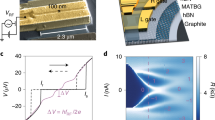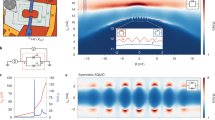Abstract
Electrical control of superconductivity is critical for nanoscale superconducting circuits including cryogenic memory elements1,2,3,4, superconducting field-effect transistors (FETs)5,6,7 and gate-tunable qubits8,9,10. Superconducting FETs operate through continuous tuning of carrier density, but no bistable superconducting FET, which could serve as a new type of cryogenic memory element, has been reported. Recently, gate hysteresis and resultant bistability in Bernal-stacked bilayer graphene aligned to its insulating hexagonal boron nitride gate dielectrics were discovered11,12. Here we report the observation of this same hysteresis in magic-angle twisted bilayer graphene (MATBG) with aligned boron nitride layers. This bistable behaviour coexists alongside the strongly correlated electron system of MATBG without disrupting its correlated insulator or superconducting states. This all-van der Waals platform enables configurable switching between different electronic states of this rich system. To illustrate this new approach, we demonstrate reproducible bistable switching between the superconducting, metallic and correlated insulator states of MATBG using gate voltage or electric displacement field. These experiments unlock the potential to broadly incorporate this new switchable moiré superconductor into highly tunable superconducting electronics.
This is a preview of subscription content, access via your institution
Access options
Access Nature and 54 other Nature Portfolio journals
Get Nature+, our best-value online-access subscription
$29.99 / 30 days
cancel any time
Subscribe to this journal
Receive 12 print issues and online access
$259.00 per year
only $21.58 per issue
Buy this article
- Purchase on Springer Link
- Instant access to full article PDF
Prices may be subject to local taxes which are calculated during checkout




Similar content being viewed by others
Data availability
The data shown in the paper are available at: https://doi.org/10.7910/DVN/FPHFDS. All other relevant data of this study are available from the corresponding authors upon reasonable request.
References
Baek, B., Rippard, W. H., Benz, S. P., Russek, S. E. & Dresselhaus, P. D. Hybrid superconducting-magnetic memory device using competing order parameters. Nat. Commun. 5, 3888 (2014).
Gingrich, E. C. et al. Controllable 0–π Josephson junctions containing a ferromagnetic spin valve. Nat. Phys. 12, 564–567 (2016).
Sardashti, K. et al. Voltage-tunable superconducting resonators: a platform for random access quantum memory. IEEE Trans. Quantum Eng. 1, 1–7 (2020).
Alam, S., Hossain, M. S., Srinivasa, S. R. & Aziz, A. Cryogenic memory technologies. Preprint at https://arxiv.org/abs/2111.09436 (2021).
Doh, Y.-J. et al. Tunable supercurrent through semiconductor nanowires. Science 309, 272–275 (2005).
De Simoni, G., Paolucci, F., Solinas, P., Strambini, E. & Giazotto, F. Metallic supercurrent field-effect transistor. Nat. Nanotechnol. 13, 802–805 (2018).
Fatemi, V. et al. Electrically tunable low-density superconductivity in a monolayer topological insulator. Science 362, 926–929 (2018).
Larsen, T. W. et al. Semiconductor-nanowire-based superconducting qubit. Phys. Rev. Lett. 115, 127001 (2015).
de Lange, G. et al. Realization of microwave quantum circuits using hybrid superconducting-semiconducting nanowire Josephson elements. Phys. Rev. Lett. 115, 127002 (2015).
Wang, J. I.-J. et al. Coherent control of a hybrid superconducting circuit made with graphene-based van der Waals heterostructures. Nat. Nanotechnol. 14, 120–125 (2019).
Zheng, Z. et al. Unconventional ferroelectricity in moiré heterostructures. Nature 588, 71–76 (2020).
Niu, R. et al. Giant ferroelectric polarization in a bilayer graphene heterostructure. Nat. Commun. 13, 6421 (2022).
Suárez Morell, E., Correa, J. D., Vargas, P., Pacheco, M. & Barticevic, Z. Flat bands in slightly twisted bilayer graphene: tight-binding calculations. Phys. Rev. B 82, 121407(R) (2010).
Bistritzer, R. & MacDonald, A. H. Moiré bands in twisted double-layer graphene. Proc. Natl Acad. Sci. USA 108, 12233–12237 (2011).
Lopes dos Santos, J. M. B., Peres, N. M. R. & Castro Neto, A. H. Continuum model of the twisted graphene bilayer. Phys. Rev. B 86, 155449 (2012).
Li, G. et al. Observation of Van Hove singularities in twisted graphene layers. Nat. Phys. 6, 109–113 (2010).
Luican, A. et al. Single-layer behavior and its breakdown in twisted graphene layers. Phys. Rev. Lett. 106, 126802 (2011).
Cao, Y. et al. Unconventional superconductivity in magic-angle graphene superlattices. Nature 556, 43–50 (2018).
Cao, Y. et al. Correlated insulator behaviour at half-filling in magic-angle graphene superlattices. Nature 556, 80–84 (2018).
Sharpe, A. L. et al. Emergent ferromagnetism near three-quarters filling in twisted bilayer graphene. Science 365, 605–608 (2019).
Serlin, M. et al. Intrinsic quantized anomalous Hall effect in a moiré heterostructure. Science 367, 900–903 (2020).
Cao, Y. et al. Strange metal in magic-angle graphene with near Planckian dissipation. Phys. Rev. Lett. 124, 076801 (2020).
Yasuda, K., Wang, X., Watanabe, K., Taniguchi, T. & Jarillo-Herrero, P. Stacking-engineered ferroelectricity in bilayer boron nitride. Science 372, 1458–1462 (2021).
Vizner Stern, M. et al. Interfacial ferroelectricity by van der Waals sliding. Science 372, 1462–1466 (2021).
Caviglia, A. D. et al. Electric field control of the LaAlO3/SrTiO3 interface ground state. Nature 456, 624–627 (2008).
Ueno, K. et al. Electric-field-induced superconductivity in an insulator. Nat. Mater. 7, 855–858 (2008).
Ye, J. T. et al. Superconducting dome in a gate-tuned band insulator. Science 338, 1193–1196 (2012).
Fausti, D. et al. Light-induced superconductivity in a stripe-ordered cuprate. Science 331, 189–191 (2011).
Yang, M., Yan, C., Ma, Y., Li, L. & Cen, C. Light induced non-volatile switching of superconductivity in single layer FeSe on SrTiO3 substrate. Nat. Commun. 10, 85 (2019).
Taniguchi, H., Kanoda, K. & Kawamoto, A. Field switching of superconductor-insulator bistability in artificially tuned organics. Phys. Rev. B 67, 014510 (2003).
Ahn, C. H. et al. Electrostatic modulation of superconductivity in ultrathin GdBa2Cu3O7−x films. Science 284, 1152–1155 (1999).
Takahashi, T. S. et al. Local switching of two-dimensional superconductivity using the ferroelectric field effect. Nature 441, 195–198 (2006).
Rodan-Legrain, D. et al. Highly tunable junctions and non-local Josephson effect in magic-angle graphene tunnelling devices. Nat. Nanotechnol. 16, 769–775 (2021).
de Vries, F. K. et al. Gate-defined Josephson junctions in magic-angle twisted bilayer graphene. Nat. Nanotechnol. 16, 760–763 (2021).
Diez-Merida, J. et al. Magnetic Josephson junctions and superconducting diodes in magic angle twisted bilayer graphene. Preprint at https://arxiv.org/abs/2110.01067 (2021).
Portolés, E. et al. A tunable monolithic SQUID in twisted bilayer graphene. Nat. Nanotechnol. 17, 1159–1164 (2022).
Park, J. M., Cao, Y., Watanabe, K., Taniguchi, T. & Jarillo-Herrero, P. Flavour Hund’s coupling, Chern gaps and charge diffusivity in moiré graphene. Nature 592, 43–48 (2021).
Acknowledgements
We thank Q. Ma and Z. Zheng for helpful discussions. This work was supported by the Air Force Office of Scientific Research 2DMAGIC MURI FA9550-19-1-0390 (D.R.K. and L.-Q.X.), the Army Research Office MURI W911NF2120147 (D.M.), and the Gordon and Betty Moore Foundation’s EPiQS Initiative through grant GBMF9463 to P.J.-H. K.W. and T.T. acknowledge support from the Elemental Strategy Initiative conducted by the MEXT, Japan (JPMXP0112101001), JSPS KAKENHI (JP20H00354), and the CREST(JPMJCR15F3), JST. This work made use of the MIT MRSEC Shared Experimental Facilities, supported by the NSF (DMR-0819762), and of Harvard’s Center for Nanoscale Systems, supported by the NSF (ECS-0335765).
Author information
Authors and Affiliations
Contributions
D.R.K., L.-Q. X., D. M. and P.J.-H. conceived the project. D.R.K. and D.M. fabricated the devices. D.R.K., L.-Q. X. and D.M. carried out the transport measurements and analysed the data. K.W. and T.T. supplied the BN crystals. D.R.K., L.-Q. X., D. M. and P.J.-H. wrote the paper with input from all authors.
Corresponding authors
Ethics declarations
Competing interests
The authors declare no competing interests.
Peer review
Peer review information
Nature Nanotechnology thanks Kam Tuen Law and Emanuel Tutuc for their contribution to the peer review of this work.
Additional information
Publisher’s note Springer Nature remains neutral with regard to jurisdictional claims in published maps and institutional affiliations.
Supplementary information
Supplementary Information
Supplementary Figs. 1–9 and Discussion.
Rights and permissions
Springer Nature or its licensor (e.g. a society or other partner) holds exclusive rights to this article under a publishing agreement with the author(s) or other rightsholder(s); author self-archiving of the accepted manuscript version of this article is solely governed by the terms of such publishing agreement and applicable law.
About this article
Cite this article
Klein, D.R., Xia, LQ., MacNeill, D. et al. Electrical switching of a bistable moiré superconductor. Nat. Nanotechnol. 18, 331–335 (2023). https://doi.org/10.1038/s41565-022-01314-x
Received:
Accepted:
Published:
Issue Date:
DOI: https://doi.org/10.1038/s41565-022-01314-x
This article is cited by
-
Engineering interlayer hybridization in van der Waals bilayers
Nature Reviews Materials (2024)
-
Correlation, superconductivity and topology in graphene moiré superlattice
Frontiers of Physics (2023)
-
2D materials for intelligent devices
Science China Physics, Mechanics & Astronomy (2023)



